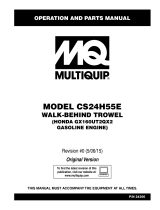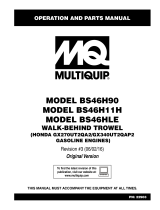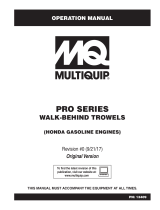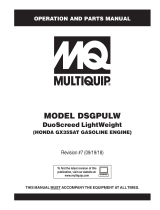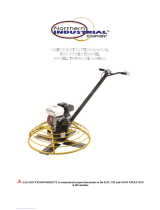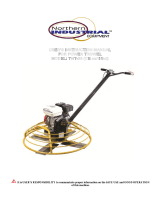Page is loading ...

To find the latest revision of this publication or
associated parts manual, visit our website at:
www.multiquip.com
OPERATION MANUAL
THIS MANUAL MUST ACCOMPANY THE EQUIPMENT AT ALL TIMES.
MODELS
J36 AND B46 SERIES
CENTRIFUGAL CLUTCH
(INCLUDES M30H55)
(HONDA/ROBIN-SUBARU GASOLINE ENGINES)
Revision #3 (05/04/20)
PN: 13401

PAGE 2 — J36/B46-M30 SERIES WALK-BEHIND TROWELS • OPERATION MANUAL — REV. #3 (05/04/20)
PROPOSITION 65 WARNING

J36/B46-M30 SERIES WALK-BEHIND TROWELS • OPERATION MANUAL — REV. #3 (05/04/20) — PAGE 3
Grinding/cutting/drilling of masonry, concrete, metal and
other materials with silica in their composition may give
off dust or mists containing crystalline silica. Silica is a
basic component of sand, quartz, brick clay, granite and
numerous other minerals and rocks. Repeated and/or
substantial inhalation of airborne crystalline silica can
cause serious or fatal respiratory diseases, including
silicosis.In addition, California and some other
authorities have listed respirable crystalline silica as a
substance known to cause cancer. When cutting such
materials, always follow the respiratory precautions
mentioned above.
WARNING
Grinding/cutting/drilling of masonry, concrete, metal and
other materials can generate dust, mists and fumes
containing chemicals known to cause serious or fatal
injury or illness, such as respiratory disease, cancer,
birth defects or other reproductive harm. If you are
unfamiliar with the risks associated with the particular
process and/or material being cut or the composition of
the tool being used, review the material safety data
sheet and/or consult your employer, the material
manufacturer/supplier, governmental agencies such as
OSHA and NIOSH and other sources on hazardous
materials. California and some other authorities, for
instance, have published lists of substances known to
cause cancer, reproductive toxicity,or other harmful
effects.
Control dust, mist and fumes at the source where
possible. In this regard use good work practices and
follow the recommendations of the manufacturers or
suppliers, OSHA/NIOSH, and occupational and trade
associations.Water should be used for dust
suppression when wet cutting is feasible. When the
hazards from inhalation of dust, mists and fumes cannot
be eliminated, the operator and any bystanders should
always wear a respirator approved by NIOSH/MSHA for
the materials being used.
WARNING
SILICOSIS WARNING RESPIRATORY HAZARDS
SILICOSIS/RESPIRATORY WARNINGS

PAGE 4 — J36/B46-M30 SERIES WALK-BEHIND TROWELS • OPERATION MANUAL — REV. #3 (05/04/20)
TABLE OF CONTENTS
J36/B46/M30 Series
Walk-Behind Power Trowels
Proposition 65 Warning ........................................... 2
Silicosis/Respiratory Warnings ................................ 3
Table of Contents ..................................................... 4
Training Checklist .................................................... 5
Daily Pre-Operation Checklist ................................. 6
Safety Information ............................................. 8–12
Specifications .................................................. 13–15
Dimensions ............................................................ 16
General Information ............................................... 17
Components .................................................... 18–20
Setup ............................................................... 21–25
Inspection ........................................................ 26–27
Operation ......................................................... 28–32
Options ............................................................ 33–34
Maintenance .................................................... 35–43
Troubleshooting ............................................... 44–47
Wiring Diagram ...................................................... 48

J36/B46-M30 SERIES WALK-BEHIND TROWELS • OPERATION MANUAL — REV. #3 (05/04/20) — PAGE 5
TRAINING CHECKLIST
Training Checklist
No. Description OK? Date
1
Read operation manual
completely.
2
Machine layout, location of
components, checking of engine
oil level.
3 Fuel system, refueling procedure.
4
Operation of controls (machine
not running).
5
Safety controls, safety stop switch
operation.
6 Emergency stop procedures.
7 Startup of machine, engine choke.
8 Maintaining a hover.
9 Maneuvering.
10 Pitching.
11 Concrete fi nishing techniques.
12 Shutdown of machine.
13 Lifting of machine (lifting bail).
14 Machine transport and storage.

PAGE 6 — J36/B46-M30 SERIES WALK-BEHIND TROWELS • OPERATION MANUAL — REV. #3 (05/04/20)
DAILY PRE-OPERATION CHECKLIST
Daily Pre-Operation Checklist
1 Engine oil level
2 Gearbox oil level
3 Condition of blades
4 Blade pitch operation
5 Safety stop switch operation

J36/B46-M30 SERIES WALK-BEHIND TROWELS • OPERATION MANUAL — REV. #3 (05/04/20) — PAGE 7
NOTES

PAGE 8 — J36/B46-M30 SERIES WALK-BEHIND TROWELS • OPERATION MANUAL — REV. #3 (05/04/20)
SAFETY INFORMATION
Do not operate or service the equipment before reading
the entire manual. Safety precautions should be followed
at all times when operating this equipment.
Failure to read and understand the safety
messages and operating instructions could
result in injury to yourself and others.
SAFETY MESSAGES
The four safety messages shown below will inform you
about potential hazards that could injure you or others. The
safety messages specifi cally address the level of exposure
to the operator and are preceded by one of four words:
DANGER, WARNING, CAUTION
or NOTICE.
SAFETY SYMBOLS
DANGER
Indicates a hazardous situation which, if not avoided,
WILL result in DEATH or SERIOUS INJURY.
WARNING
Indicates a hazardous situation which, if not avoided,
COULD result in DEATH or SERIOUS INJURY.
CAUTION
Indicates a hazardous situation which, if not avoided,
COULD result in MINOR or MODERATE INJURY.
NOTICE
Addresses practices not related to personal injury.
Potential hazard associated with the operation of this
equipment will be referenced with hazard symbols
which
may appear throughout this manual in conjunction with
safety messages.
Warning decals
associated with the operation of this
equipment are defi ned below:
Inhaling exhaust fumes can result in severe
injury or death.
Only operate equipment in well ventilated areas.
inhale exhaust gases/fumes.DO NOT
WARNING
Lethal Exhaust Gas Hazard
HOT PARTS can burn skin.
CAUTION
Burn Hazard
touch hot parts. Allow machine a sufficient
amount of time to cool before performing maintenance.
DO NOT
Gasoline fuel can cause fire or explosion. Stop
engine before refueling.
Keep cigarettes, sparks and flames away from hot
surfaces.
WARNING
Explosive Fuel Hazard
SYMBOL
SAFETY HAZARD
Keep hands and feet clear of guard rings.
Stop engine before servicing.
WARNING
Rotating Blade Hazard
To avoid injury you must read and
understand operator’s manual before
using this machine.
P/N 23700
allow any person
to stand underneath the trowel while lifting.
NEVER
P/N 360
99
ALWAYS wear protective clothing when
operating this equipment
This machine to be operated by qualified
personnel. Ask for training as needed.
Lifting Crush Hazard
lift trowel with pans attached.DO NOT
WARNING
WARNING
Read Manual
NEVER operate this equipment with guards
removed. Keep hands clear.
WARNING
Training
Guard Hazard
WARNING
make sure handle is securely attached.
On Quick Pitch™ models make sure T-Handle
latch is locked (engaged).
ALWAYS
DECAL
SAFETY HAZARD

J36/B46-M30 SERIES WALK-BEHIND TROWELS • OPERATION MANUAL — REV. #3 (05/04/20) — PAGE 9
SAFETY INFORMATION
GENERAL SAFETY
CAUTION
NEVER operate this equipment without proper protective
clothing, shatterproof glasses, respiratory protection,
hearing protection, steel-toed boots and other protective
devices required by the job or city and state regulations.
Avoid wearing jewelry or loose fi tting clothes that may
snag on the controls or moving parts as this can cause
serious injury.
NEVER operate this equipment when not
feeling well due to fatigue, illness or when
under medication.
NEVER operate this equipment under the
infl uence of drugs or alcohol.
ALWAYS clear the work area of any debris, tools, etc.
that would constitute a hazard while the equipment is
in operation.
No one other than the operator is to be in the working
area when the equipment is in operation.
DO NOT use the equipment for any purpose other than
its intended purposes or applications.
NOTICE
This equipment should only be operated by trained and
qualifi ed personnel 18 years of age and older.
Whenever necessary, replace nameplate, operation and
safety decals when they become diffi cult read.
Manufacturer does not assume responsibility for any
accident due to equipment modifi cations. Unauthorized
equipment modifi cation will void all warranties.
NEVER
use accessories or attachments that are not
recommended by Multiquip for this equipment. Damage
to the equipment and/or injury to user may result.
ALWAYS know the location of the nearest
fi re extinguisher.
ALWAYS know the location of the nearest
fi rst aid kit.
ALWAYS know the location of the nearest phone or
keep
a phone on the job site.
Also, know the phone numbers
of the nearest ambulance, doctor and
fi re department.
This information will be invaluable in the case of an
emergency.

PAGE 10 — J36/B46-M30 SERIES WALK-BEHIND TROWELS • OPERATION MANUAL — REV. #3 (05/04/20)
SAFETY INFORMATION
TROWEL SAFETY
DANGER
Engine fuel exhaust gases contain poisonous carbon
monoxide. This gas is colorless and odorless, and can
cause death if inhaled.
The engine of this equipment requires an adequate free
fl ow of cooling air. NEVER operate this equipment in any
enclosed or narrow area
where free fl ow of the air is
restricted. If the air fl ow is
restricted it will cause injury
to people and property and
serious damage to the
equipment or engine.
NEVER operate the equipment in an explosive
atmosphere or near combustible materials. An
explosion or fi re could result causing severe
bodily harm or even death.
WARNING
ALWAYS keep clear of rotating or moving
parts while operating the trowel.
DO NOT start or operate the trowel if the
drive train will not disengage. Centrifugal
force between the trowel and surface when starting can
cause uncontrolled handle movement that can cause
serious injury. The handle must not move while pulling
the engine recoil starter.
NEVER disconnect any emergency or safety devices.
These devices are intended for operator safety.
Disconnection of these devices can cause severe injury,
bodily harm or even death. Disconnection of any of these
devices will void all warranties.
CAUTION
NEVER stand on trowel during operation.
NEVER lubricate components or attempt service on a
running machine.
NEVER place your feet or hands inside the guard rings
while starting or operating this equipment.
DANGEROUS
GAS FUMES
K
E
E
P
C
L
E
A
R
ALWAYS keep work area
clear around the trowel.
Make sure it is free of
debris and objects.
NOTICE
ALWAYS keep the machine in proper running condition.
Fix damage to machine and replace any broken parts
immediately.
ALWAYS
store equipment properly when it is not being
used. Equipment should be stored in a clean, dry location
out of the reach of children and unauthorized personnel.
A safety manual for operating and maintenance
personnel of concrete power trowels produced by the
Association of Equipment Manufacturers (AEM) can be
obtained for a fee by ordering through their website at
www.aem.org.
Order FORM PT-160
ENGINE SAFETY
WARNING
DO NOT
place hands or fingers inside engine
compartment when engine is running.
NEVER
operate the engine with heat shields or
guards removed.
Keep fi ngers, hands hair and clothing away
from all moving parts to prevent injury.
DO NOT remove the engine oil drain plug
while the engine is hot. Allow the oil to cool before
performing maintenance. This will prevent scalding of
personnel.
CAUTION
NEVER touch the hot exhaust manifold,
muffl er or cylinder. Allow these parts to cool
before servicing equipment.

J36/B46-M30 SERIES WALK-BEHIND TROWELS • OPERATION MANUAL — REV. #3 (05/04/20) — PAGE 11
SAFETY INFORMATION
NOTICE
NEVER run engine without an air fi lter or with a dirty air
fi lter. Severe engine damage may occur. Service air fi lter
frequently to prevent engine malfunction.
NEVER tamper with the factory settings
of the engine or engine governor. Damage
to the engine or equipment can result
if operating in speed ranges above the
maximum allowable.
FUEL SAFETY
DANGER
DO NOT add fuel to equipment if it is placed inside
truck bed with plastic liner. Possibility exists of explosion
or fi re due to static electricity.
DO NOT start the engine near spilled fuel or combustible
fl uids. Fuel is extremely fl ammable and its vapors can
cause an explosion if ignited.
ALWAYS refuel in a well-ventilated area, away from
sparks and open fl ames.
ALWAYS use extreme caution when working with
fl ammable liquids.
DO NOT fi ll the fuel tank while the engine is running
or hot.
DO NOT overfi ll tank, since spilled fuel could ignite if it
comes into contact with hot engine parts or sparks from
the ignition system.
FUEL
FUEL
Store fuel in appropriate containers, in well-ventilated
areas and away from sparks and fl ames.
NEVER use fuel as a cleaning agent.
DO NOT smoke around or near the
equipment. Fire or explosion could result
from fuel vapors or if fuel is spilled on a
hot engine.
TRANSPORTING SAFETY
CAUTION
NEVER allow any person or animal to
stand underneath the equipment while
lifting.
NOTICE
Some walk-behind trowels can be lifted or moved by two
people utilizing lifting tubes or other special attachments.
Generally, however, they must be lifted using lifting bales
and cranes, hoists, or forklifts.
NEVER
transport trowel with fl oat pans attached unless
safety catches are used and are specifi cally cleared for
such transport by the manufacturer.
NEVER
hoist the trowel more than three feet off the
ground with fl oat pans attached.
Before lifting, make sure that the lifting bales are not
damaged.
Always make sure crane or lifting device has been
properly secured to the lifting bales of the equipment.
ALWAYS shutdown engine before transporting.
NEVER lift the equipment while the engine is running.
Tighten fuel tank cap securely and close fuel cock to
prevent fuel from spilling.
Use adequate lifting cable (wire or rope) of suffi cient
strength.
DO NOT lift machine to unnecessary heights.
ALWAYS
tie down equipment during transport by
securing the equipment with rope.

PAGE 12 — J36/B46-M30 SERIES WALK-BEHIND TROWELS • OPERATION MANUAL — REV. #3 (05/04/20)
SAFETY INFORMATION
ENVIRONMENTAL SAFETY/DECOMMISSIONING
NOTICE
Decommissioning is a controlled process used to safely
retire a piece of equipment that is no longer serviceable.
If the equipment poses an unacceptable and unrepairable
safety risk due to wear or damage or is no longer cost
effective to maintain (beyond life-cycle reliability) and is to
be decommissioned (demolition and dismantlement),be
sure to follow rules below.
DO NOT pour waste or oil directly onto the ground, down
a drain or into any water source.
Contact your country's Department of
Public Works or recycling agency in your
area and arrange for proper disposal of
any electrical components, waste or oil
associated with this equipment.
When the life cycle of this equipment is over, remove
battery and bring to appropriate facility for lead
reclamation. Use safety precautions when handling
batteries that contain sulfuric acid.
When the life cycle of this equipment is over, it is
recommended that the trowel frame and all other metal
parts be sent to a recycling center.
Metal recycling involves the collection of metal from
discarded products and its transformation into raw
materials to use in manufacturing a new product.
Recyclers and manufacturers alike promote the process
of recycling metal. Using a metal recycling center
promotes energy cost savings.
EMISSIONS INFORMATION
NOTICE
The gasoline engine used in this equipment has been
designed to reduce harmful levels of carbon monoxide
(CO), hydrocarbons (HC) and nitrogen oxides (NOx)
contained in gasoline exhaust emissions.
This engine has been certifi ed to meet US EPA Evaporative
emissions requirements in the installed confi guration.
Attempting to modify or make adjustments to the engine
emmission system by unauthorized personnel without
proper training could damage the equipment or create an
unsafe condition.
Additionally, modifying the fuel system may adversely affect
evaporative emissions, resulting in fi nes or other penalties.
Emission Control Label
The emission control label is an integral part of the emission
system and is strictly controlled by regulation(s).
The label must remain with the engine for its entire life.
If a replacement emission label is needed, please contact
your authorized engine distributor.

J36/B46-M30 SERIES WALK-BEHIND TROWELS • OPERATION MANUAL — REV. #3 (05/04/20) — PAGE 13
SPECIFICATIONS (TROWEL)
Table 1. J36 Series Trowel Specifications
Model J36H55/J36R60/J36S60 J36H90/J36R90 J36H90H/J36R90H M30H55
Number of Blades 4
Ring Diameter 37.4 in. (949 mm) 31.7 in. (805 mm)
Rotor RPM 60–115 60–130 90–155 60–130
Path Width 36 in. (914 mm) 30 in. (762 mm)
Shipping Weight 182 lb. (82.6 kg) 182 lb. (82.6 kg) 207 lb. (93.9 kg) 195 lb. (88.5 kg)
Table 2. B46 Series Trowel Specifications
Model B46H90/B46R90/B46H11 B46H11H B46S90
Number of Blades 4
Ring Diameter 48 in. (1,219 mm)
Rotor RPM 60–130 90–155 60–130
Path Width 46 in. (1,168 mm)
Shipping Weight 285 lb. (129.3 kg) 300 lb. (136.1 kg)

PAGE 14 — J36/B46-M30 SERIES WALK-BEHIND TROWELS • OPERATION MANUAL — REV. #3 (05/04/20)
SPECIFICATIONS (ENGINE)
Table 3. Honda Engine Specifications
Engine Model
Honda
GX160UT2QX2
Honda
GX270UTQA2
Honda
GX340U1QAP2
Trowel Model JH55C/M30H55
J36H90/J36H90H
B46H90
B46H11/B46H11H
Type Air-cooled, 4-stroke, single-cylinder, OHV, horizontal PTO shaft, gasoline engine
Bore × Stroke
2.7 in. × 1.8 in.
(69 mm × 46 mm)
3.0 in. × 2.3 in.
(76 mm × 58 mm)
3.2 in. × 2.5 in.
(81 mm × 64 mm)
Displacement 163 cm³ 270 cm³ 387 cm³
Max Output 5.4 hp @ 3,600 rpm 9 hp @ 3,600 rpm 11 hp @ 3,600 rpm
Fuel Tank Capacity
~ 0.95 U.S. gallons
(3.6 liters)
~ 1.59 U.S. gallons
(6.02 liters)
~ 1.72 U.S. gallons
(6.5 liters)
Fuel Unleaded gasoline
Lube Oil Capacity 0.63 qt. (0.6 liters) 1.06 qt. (1.0 liters) 1.06 qt. (1.0 liters)
Oil Type 4-stroke API, SF or SG SAE 10W-30 general use
Speed Control Method Centrifugal flyweight type
Starting Method Recoil start
Dimensions
(L × W × H)
12.3 × 14.3 × 13.2 in.
(312 × 363 × 335 mm
14.0 × 16.9 × 16.1 in.
(356 × 429 × 409 mm)
16.7 × 17.7 × 17.4 in.
(424 × 450 × 442 mm)
Dry Net Weight 33.1 lb. (15 kg) 55.1 lb. (25 kg) 68 lb. (29 kg)
Table 4. Robin/Subaru Engine Specifications
Engine Model
Robin
EX170D50040
Robin
EX270D50020
Subaru
EX170DM2230
Subaru
EX270D5E5013
Trowel Model J36R60
J36R90/J36R90H
B46R90
J36S60 B46S90
Type Air-cooled, 4-stroke, slant single-cylinder, OHC, horizontal PTO shaft, gasoline engine
Bore × Stroke
2.64 in. × 1.89 in.
(67 mm × 48 mm)
2.95 in. × 2.36 in.
(75 mm × 60 mm)
2.64 in. × 1.89 in.
(67 mm × 48 mm)
2.95 in. × 2.36 in.
(75 mm × 60 mm)
Displacement 169 cm³ 265 cm³ 10.31 in³ (169 cm³) 265 cm³
Max Output 5.7 hp @ 4,000 rpm 9 hp @ 4,000 rpm 5.7 hp @ 4,000 rpm 9 hp @ 4,000 rpm
Fuel Tank Capacity
~ 0.95 U.S. gallons
(3.6 liters)
~ 1.59 U.S. gallons
(6.02 liters)
~ 0.95 U.S. gallons
(3.6 liters)
~ 1.59 U.S. gallons
(6.02 liters)
Fuel Unleaded gasoline
Lube Oil Capacity 0.63 qt. (0.6 liters) 1.06 qt. (1.0 liters) 0.63 qt. (0.6 liters) 1.06 qt. (1.0 liters)
Oil Type 4-stroke API, SF or SG SAE 10W-30 general use
Speed Control
Method
Centrifugal flyweight type
Starting Method Recoil start
Dimensions
(L × W × H)
11.97 × 13.94 × 13.2 in.
(304 × 354 × 335 mm)
13.82 × 16.54 × 16.14 in.
(351 × 420 × 410 mm)
11.97 × 13.94 × 13.19 in.
(304 × 354 × 335 mm)
13.82 × 16.54 × 16.14 in.
(351 × 420 × 410 mm)
Dry Net Weight 33.1 lb. (15 kg) 46.3 lb. (21 kg) 33.1 lb. (15 kg) 46.3 lb. (21 kg)

J36/B46-M30 SERIES WALK-BEHIND TROWELS • OPERATION MANUAL — REV. #3 (05/04/20) — PAGE 15
SPECIFICATIONS (EMISSIONS)
NOTES:
1. Sound pressure and power levels are “A” weighted measures per ISO 3744:2010. They are measured with the operating conditions of the
machine which generate the most repeatable but highest values of the sound levels. Under normal circumstances, the sound level will vary
depending on the condition of the material being worked upon.
2. The vibration level indicated is the vector sum of the RMS (root mean square) values of amplitudes on each axis, standardized to an 8-hour
exposure period, and obtained using the operating condition of the machine that generates the most repeatable but highest values in accordance
with the applicable standards for the machine.
3. Per EU Directive 2002/44/EC, the daily exposure action value for hand/arm vibration is 2.5 m/s
2
∑A(8). The daily exposure limit value
is 5 m/s
2
∑A(8).
Table 5. J36 Series Trowel Noise and Vibration Emissions
Model J36H55 J36R60 J36S60 J36H90 J36R90 J36H90H J36R90H M30H55
Guaranteed ISO
11201:2010 Based
Sound Pressure Level at
Operator Station in dB(A)
a
Quick Pitch
TM
Handle
87 91 90.79 N/A N/A 90 N/A N/A
Standard Handle 87 91 90.79 N/A N/A 90 N/A N/A
Guaranteed ISO
3744:2010 Based Sound
Power Level in dB(A)
b
Quick Pitch
TM
Handle
108 105 104.3 N/A N/A 107 N/A N/A
Standard Handle 108 105 104.3 N/A N/A 107 N/A N/A
Hand-Arm Vibration per
ISO 5349-1:2001
in m/s
2
∑A(8)
Quick Pitch
TM
Handle
1.6 1.18 1.18 N/A N/A 0.98 N/A N/A
Standard Handle 1.1 1.20 1.20 N/A N/A 1.50 N/A N/A
Table 6. B46 Series Trowel Noise and Vibration Emissions
Model B46H90 B46S90 B46H11 B46R90 B46H11H
Guaranteed ISO 11201:2010
Based Sound Pressure Level
at Operator Station in dB(A)
a
Quick Pitch
TM
Handle
89 86.76 90.79 N/A N/A
Standard Handle 89 86.76 90.79 N/A N/A
Guaranteed ISO 3744:2010 Based
Sound Power Level in dB(A)
b
Quick Pitch
TM
Handle
111 105.11 104.3 N/A N/A
Standard Handle 111 105.11 104.3 N/A N/A
Hand-Arm Vibration per ISO 5349-
1:2001 in m/s
2
∑A(8)
Quick Pitch
TM
Handle
1.7 0.87 1.18 N/A N/A
Standard Handle 1.51 0.97 1.20 N/A N/A
a. With an uncertainty factor K of 2.5 dB (A) included per Note 1 in section 7.2.1 of EN 12649::2008+A1:2011
b. With an uncertainty factor K of 1.5 dB (A) included per Note 1 in section 7.2.1 of EN 12649::2008+A1:2011

PAGE 16 — J36/B46-M30 SERIES WALK-BEHIND TROWELS • OPERATION MANUAL — REV. #3 (05/04/20)
DIMENSIONS
Figure 1. Trowel Dimensions
AAA
B
SIDE VIEW
C
D
TOP VIEW
Standard Handle Shown
Table 7. Trowel Dimensions
Model J36 Series M30H55 B46 Series
(A) Height (Lifting Bail) 27 in. (686 mm) 26 in. (660 mm) 31.5 in. (800 mm)
(B) Height (Handle) 41.5 in. (1,054 mm)
(C) Width (Ring Diameter) 37.4 in. (949 mm) 31.7 in. (805 mm) 48 in. (1,219 mm)
(D) Length 74 in. (1,880 mm) 68 in. (1,727 mm) 81.4 in. (2,068 mm)

J36/B46-M30 SERIES WALK-BEHIND TROWELS • OPERATION MANUAL — REV. #3 (05/04/20) — PAGE 17
GENERAL INFORMATION
INTENDED USE
Operate this trowel, its components and tools in accordance
with the manufacturer’s instructions. Use of any other tools
for stated operation is considered contrary to designated
use. The risk of such use lies entirely with the user. The
manufacturer cannot be held liable for damages as a result
of misuse.
TROWEL FAMILIARIZATION
Read all safety instructions carefully. Safety instructions
will be found throughout this manual and on the trowel. Keep
all safety information in good, readable condition. Operators
should be well trained on the operation and maintenance
of the trowel.
This walk-behind trowel is designed for the floating and
finishing of concrete slabs.
Walk around the trowel and take notice of all the major
components (Figure 2)—the engine, blades, steering
handle, gearbox, etc. Make sure there is always oil in the
engine.
Before using your trowel, test it on a flat, watered-down
section of finished concrete that is free of debris and other
objects.
This trial test run will increase your confidence in using the
trowel and will familiarize you with the trowel’s controls. You
will learn how the trowel handles under actual conditions.
Engine
These trowels are equipped with gasoline engines
(see Table 3 and Table 4) that range from 5.4 to 11
horsepower. Refer to the engine owner’s manual for
instructions regarding the operation and maintenance of
your engine. If the original manual is lost or damaged, please
contact your nearest Multiquip dealer for a replacement.
Drive System
Power is transferred from the engine to the gearbox input
shaft via a V-belt pulley drive system. The pulley engages
a centrifugal clutch.
Gearbox
The gearbox is located beneath the engine and transfers
power to the spider assembly. The gearbox controls the
rotational speed of the trowel and is equipped with two
shafts (input and output).
Spider
The vertical output shaft of the gearbox connects to a
cast hub called the spider. The spider has four arms that
extend outward, to which blades or other accessories are
attached. As the gearbox output shaft rotates, so does the
spider assembly.
Blades
The blades of the trowel finish concrete as they are rotated
around the surface. This trowel comes equipped with four
combination blades, equally spaced in a radial pattern,
attached to the vertical rotating shaft by means of the
spider assembly.
Guard Ring
This unit is equipped with a safety guard ring to help prevent
objects from coming into contact with the rotating blades
while the trowel is in operation.
Centrifugal Safety Stop Switch
In the event of a trowel runaway condition (the operator
releases the handlebar during operation), the centrifugal
safety stop switch will stop the engine and bring the trowel
to a halt.
TRAINING
For proper training, please use the Training Checklist
form located in the front of this manual. This checklist will
provide an outline for an experienced operator to provide
training to a new operator.

PAGE 18 — J36/B46-M30 SERIES WALK-BEHIND TROWELS • OPERATION MANUAL — REV. #3 (05/04/20)
COMPONENTS (TROWEL)
Figure 2. Trowel Components
QUICK PITCH™
HANDLE (OPTION)
2
3
1
4
5
6
7
8
9
10
11
12
13
14
15
16
17

J36/B46-M30 SERIES WALK-BEHIND TROWELS • OPERATION MANUAL — REV. #3 (05/04/20) — PAGE 19
Figure 2 shows the location of the basic trowel components.
Listed below is a brief explanation of each component.
1. Access Panel — Allows access to the blade area.
NEVER run the trowel with the access panel removed.
2. Engine — Gasoline engine. Refer to Table 3 and
Table 4 for engine specifications.
3. Lifting Bail — Attach a suitable lifting device to the
lifting bail whenever lifting of the trowel is required.
4. Throttle Lever — Controls engine speed. Returns the
engine to idle when released.
5. Operator Presence Lever (Optional) — In the event
of a trowel runaway condition (the operator releases
the handle), the operator presence lever signals the
safety stop switch which will stop the engine and bring
the trowel to a halt.
6. Vibratory Handlebar — Rubber shock mounts/
isolators reduce trowel vibration.
7. Pitch Control Star Wheel — To adjust the pitch
of the blades, rotate the star wheel clockwise to
pitch the blades upward. Rotate the star wheel
counterclockwise to pitch the blades flat (no pitch).
8. Handlebar Pad — Foam rubber pad that protects the
body when coming into contact with the handlebar.
9. Hand Grips (2) — ALWAYS place hands on both hand
grips when maneuvering the trowel. Replace hand grips
when they become worn or damaged.
10. Handlebar Adjuster — Change the angle or height
of the handlebar by loosening the star wheel. Adjust
the handlebar to the desired location and tighten the
star wheel firmly to secure the handlebar in position.
11. Centrifugal Safety Stop Switch — If the operator
loses control of the trowel, this switch will shut down
the engine.
12. Blades (4) — Versatile combination blades should take
care of most troweling needs.
13. V-Belt Cover — Remove this cover to gain access to
the V-belt. NEVER operate the trowel with this cover
removed.
14. Guard Ring — NEVER put hands or feet inside the
guard ring while the engine is running.
15. Gearbox — Helical worm gear drive gearbox. Provides
rotation of blades via engine interface. ALWAYS check
the gearbox oil level (sight glass) prior to each use. Fill
with Chevron Cetus
®
HiPerSYN
®
460 synthetic oil as
needed.
16. Trowel Arms (4) — Combination blades attach here.
In addition, float pans can be attached to the trowel
arms that will allow the trowel to ‘float’ on wet concrete.
17. Quick Pitch™ Control Handle — To adjust the pitch
of the blades upward using the Quick Pitch™ handle,
simply pull the T-handle backward while squeezing the
trigger. Push the T-handle forward to pitch the blades flat
(no pitch). Contact Multiquip unit sales to purchase
this option.
NOTICE
NEVER operate the trowel with a bent, broken, or
out-of-adjustment trowel arm. If the blades show uneven
wear patterns, or some blades wear out faster than
others, the trowel arm may need to be adjusted. Refer
to the Maintenance section for more information.
COMPONENTS (TROWEL)

PAGE 20 — J36/B46-M30 SERIES WALK-BEHIND TROWELS • OPERATION MANUAL — REV. #3 (05/04/20)
COMPONENTS (ENGINE)
Figure 3. Basic Engine Components
2
6
8
9
7
4
10
2
8
6
9
4
5
11
7
1
11
5
CLOSE
OPEN
HONDA GX
ROBIN-SUBARU EX
1
3
10
3
INITIAL SERVICING
The engine (Figure 3) must be checked for proper
lubrication and filled with fuel prior to operation. Refer to
the manufacturer’s engine manual for detailed operation
and service instructions.
1. Fuel Filler Cap/Fuel Tank — Remove this cap to add
unleaded gasoline to the fuel tank. Refer to Table 3
or Table 4 for fuel tank capacity. Make sure the cap is
tightened securely. DO NOT overfill.
2. Throttle Lever — Adjusts engine RPM speed.
3. Engine ON/OFF Switch — ON position permits engine
starting. OFF position stops engine operation.
4. Recoil Starter — Manual starting method. Pull the
starter grip until resistance is felt, then pull briskly and
smoothly to start the engine.
5. Oil Drain Bolt — Remove this bolt to drain oil from the
engine crankcase.
DANGER
Add fuel to the tank only when the engine
is stopped and has had an opportunity
to cool down. In the event of a fuel spill,
DO NOT attempt to start the engine until all
fuel residue has been completely wiped up
and the area surrounding the engine is dry.
6. Fuel Valve Lever — Open to allow fuel to flow. Close
to prevent fuel flow.
7. Oil Filler Cap/Dipstick — Remove this cap to
determine if engine oil is low. Add oil through this filler
port as recommended in Table 8.
8. Choke Lever — Used in cold weather conditions or
for the starting of a cold engine. The choke enriches
the fuel mixture.
9. Air Cleaner — Prevents dirt and other debris from
entering the fuel system. Remove the wing nut on
top of the air cleaner cover to gain access to the filter
elements.
10. Spark Plug — Provides spark to the ignition system.
Set the spark plug gap according to the engine
manufacturer’s instructions. Clean the spark plug once
a week.
11. Muffler — Reduces noise and emissions. NEVER
touch the muffler while it is hot!
NOTICE
Operating the engine without an air cleaner, with a
damaged air cleaner, or with an air cleaner in need of
replacement will allow dirt to enter the engine, causing
rapid engine wear.
/
